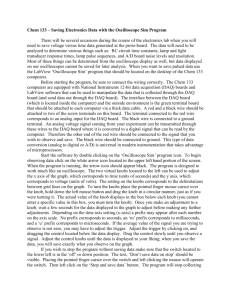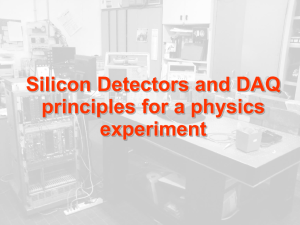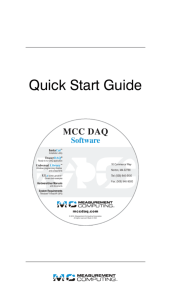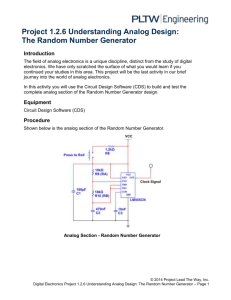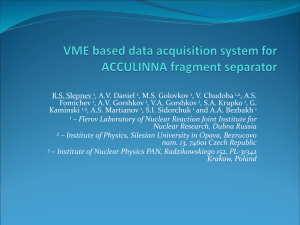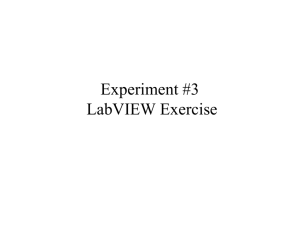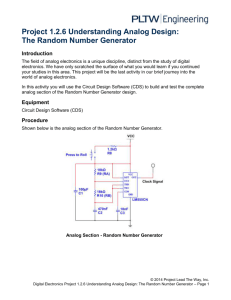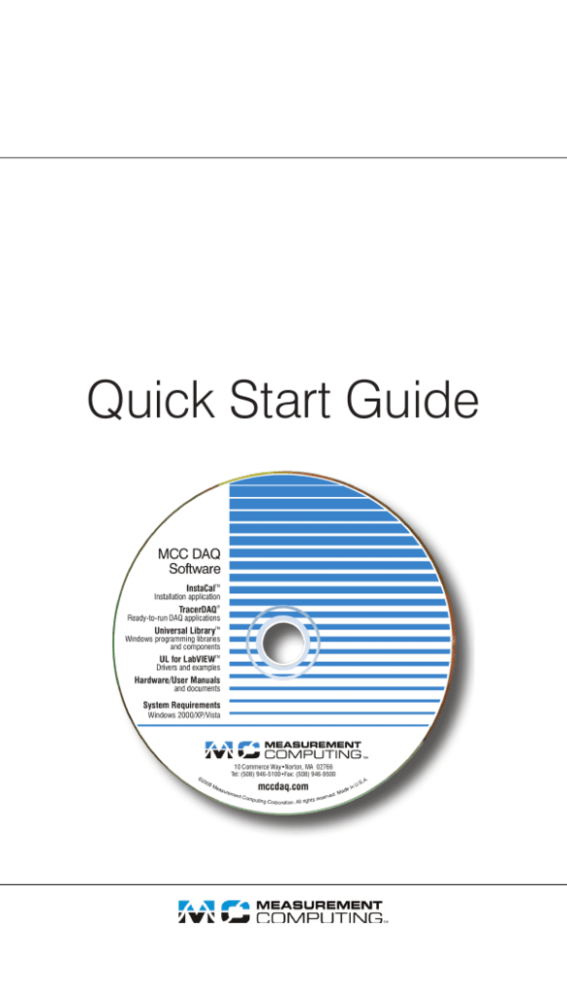
Quick Start Guide
Quick Start Guide
Measurement Computing DAQ Software
Document Revision 13, July, 2009
© Copyright Measurement Computing Corp. 2005-2009
Table of Contents
About Measurement Computing data acquisition software ..... 3
■ System requirements ...........................................................................3
■ For more information… ......................................................................5
Installing the Measurement Computing DAQ software ............. 7
Installing the hardware and detecting it with Windows .......... 10
Adding new hardware to InstaCal.............................................. 11
■ Overview: InstaCal ...........................................................................11
■ Installation ........................................................................................11
■ Configuration ....................................................................................12
■ Calibration ........................................................................................12
■ Test ...................................................................................................12
Running InstaCal and adding DEMO_BOARD hardware ........ 14
■ Running InstaCal and adding the DEMO-BOARD ..........................14
Configuring and testing the DEMO-BOARD with InstaCal...... 16
■ Configuring channel 0 on the DEMO-BOARD ................................16
■ Testing channel 0 on the DEMO-BOARD........................................16
Plotting and generating data with TracerDAQ ......................... 18
■ Acquiring and logging data with the Strip Chart...............................18
■ Acquiring data with the Oscilloscope ...............................................22
■ Generating waveforms with the Function Generator.........................25
■ Generating waveforms with the Rate Generator ...............................29
Getting started with the Universal Library................................ 34
Getting started with the Universal Library for LabVIEW ......... 36
Opening your hardware user's guides ...................................... 38
Problems installing or running your DAQ software? .............. 40
SM MCC_DAQ_Softwareweb.doc
2
About Measurement Computing
data acquisition software
This Quick Start Guide contains the latest information on
installing the Measurement Computing Data Acquisition
Software you received with your Measurement Computing
hardware. Please read this booklet completely before you
install any software or hardware.
Measurement Computing's data acquisition software includes
the following software packages:
InstaCal & Universal Library — Installation, calibration,
and test utility, and programming library for Measurement
Computing data acquisition hardware.
TracerDAQ — Professional grade Strip Chart,
Oscilloscope, Function Generator, and Rate Generator
applications.
Universal Library for LabVIEW™ — LabVIEW drivers
for Measurement Computing data acquisition hardware.
Hardware User's Guides — Hardware user's guides for
Measurement Computing data acquisition hardware.
You select the packages that you want to install from the
software installation dialog.
■
System requirements
You can install this Measurement Computing Data
Acquisition Software package on a computer running one of
these operating systems:
Windows 2000 with Service Pack 4 (SP4)
Windows XP with Service Pack 2 (SP2)
Windows VISTA 32-bit version (only PCI and USB
Measurement Computing hardware currently supported)
These operating systems are the only requirements for
running InstaCal.
3
About Measurement Computing data acquisition software
The hardware and software requirements for the other
packages are listed next.
Universal Library
Application development software that supports one or more
of these 32-bit languages.
Microsoft® Windows® languages: Visual Basic and
Visual C/C++
.NET languages: VB .NET, C# .NET (Visual Studio®
2003 and 2005)
Borland® Windows languages: Borland C++, Borland
C++ Builder®, Delphi®
TracerDAQ
You can run TracerDAQ on a computer running one of the
following operating systems and software.
Microsoft® Windows 2000 (SP4), Windows XP (SP2),
Windows Vista
Microsoft .NET® Framework 2.0
DirectX 9.0c
Measurement Computing's InstaCal
Microsoft .NET® Framework 2.0 and DirectX 9.0c
automatically install with TracerDAQ if these applications
are not already installed.
Hardware requirements
Video card with 16 MB of memory and support for
Direct3D Acceleration
Minimum screen resolution of 1024 x 768
Computer with Pentium® 4 processor and 256 MB of
RAM
A Microsoft-compatible mouse
Supported Measurement Computing data acquisition
hardware—PCI, USB, and WLS Series, or PC-CARD
devices
4
About Measurement Computing data acquisition software
Universal Library for LabVIEW
InstaCal & Universal Library
LabVIEW 6.0 or later
Hardware User's Guides
Software requirements
®
®
Adobe Reader
Adobe Reader is automatically selected if you select to
install the hardware user's guides and do not have this
program currently installed.
If you do not install the Measurement Computing hardware
user's guides during the DAQ software installation, you can
open or copy these documents from the
ICalUL/Documents/UsersGuides folder on the Measurement
Computing DAQ Software CD.
To use Measurement Computing DAQ software with a
Measurement Computing device, install the latest Windows
Update. You can run Windows Update from
update.microsoft.com/windowsupdate/v6/default.aspx?ln=en
-us.
■
For more information…
If you have questions that you cannot answer by reading this
booklet, refer to these resources:
Tech support contact information:
Tech support
form: .mccdaq.com/support/support_form.aspx
Email: @mccdaq.com
Phone: 508-946-5100 and follow the instructions for
reaching Tech Support.
Fax: 508-946-9500 to the attention of Tech Support
Web site – .mccdaq.com
5
About Measurement Computing data acquisition software
Measurement Computing product manuals (PDF)
at .mccdaq.com/manuals.aspx, and Measurement
Computing detailed product specifications (PDF)
at .mccdaq.com/specs.aspx.
6
Installing the Measurement
Computing DAQ software
The DAQ Software installation program consists of a series
of easy-to-follow dialogs that lead you through the
installation procedure. To install the Measurement
Computing DAQ software, do the following.
1. Insert the Measurement Computing Data Acquisition
Software CD in your CD drive and wait for the installation
program to start.
If the installation program does not start automatically, use
Windows Explorer to browse to the root of the CD, and
.
double-click on
The MCC DAQ dialog opens.
All software packages are selected for installation ( ) by
default if the requirements for the package are met.
○ When you click on a package, a brief description of
it appears in the Description frame, along with the
requirements to install that package.
○ After you click on a package, you can click on the
View ReadMe button to view the readme file for
that package.
7
Installing the Measurement Computing DAQ software
2. If you do not want to install a software package, click on
the check box next to it to uncheck it ( ).
The Required dependencies area of the dialog lists the
software packages needed to run the Measurement
Computing DAQ software you selected to install. This
area may be blank, or may list one or more of the
following packages.
Adobe Reader - Adobe Reader is required to read the
hardware user's guides. If you do not have Adobe Reader
installed, it is selected in the Required dependencies
area.
If you have an earlier version already installed, installing
the latest version is optional. Deselect the Adobe Reader
check box to keep your currently installed version.
Microsoft .NET framework - The .NET Framework 2.0
is required to install TracerDAQ and the hardware user's
guides. If the framework is not detected on your PC, this
package is listed and the checkbox checked. In this case, it
is recommended that you leave the Microsoft .NET
framework check box checked. If you uncheck the
Microsoft .NET framework check box, the TracerDAQ
and Hardware Manuals check boxes become disabled,
the Adobe Reader check box becomes unchecked, and
these software packages do not get installed.
3. Click on the Install button and follow the instructions on
the installation dialogs.
If Microsoft .NET framework was listed and checked in
the Required dependencies area, the install program
installs version 2.0 of the .NET framework before
launching the InstaCal & Universal Library installation
program. The installation program automatically installs
each selected software product in succession. After all of
the selected Measurement Computing DAQ components
are installed, a dialog opens which allows you to install
Adobe Acrobat Reader.
8
Installing the Measurement Computing DAQ software
Installation of InstaCal & Universal Library requires you to
restart your computer after installing. You are prompted to
restart your computer after all of the selected products are
installed.
9
Installing the hardware and
detecting it with Windows
After you install the Measurement Computing Data
Acquisition Software, install your hardware and let it be
detected by Windows.
For PCI devices, turn the PC off, install the device into a
PCI slot, and turn the PC back on.
When you power up the PC, a "Found new hardware"
message appears as the device is detected by Windows. A
New Hardware Wizard automatically runs and installs the
drivers required to operate the device.
For plug-and-play USB devices, connect a USB cable
between the device and the PC.
A "Found new hardware" message appears as the device is
detected by Windows. A New Hardware Wizard
automatically runs and installs the drivers required to
operate the device.
Additional New Hardware Wizard may appear
When installing some measurement computing devices,
such as the USB-2416 Series and USB-2404 Series, an
additional New hardware Wizard may appear when you
install the hardware. This wizard is required to install
additional drivers specific to this hardware. DO NOT
CANCEL THIS WIZARD or installation of the hardware
will not be completed properly.
10
Adding new hardware to
InstaCal
After the device is detected with Windows, run InstaCal
from the Windows Start Menu or from the installation
directory (inscal32.exe) so that it can detect the new
hardware and add it to its configuration file.
Measurement Computing hardware cannot be used with
Universal Library programs until they are first detected by
InstaCal and added to the configuration file.
■
Overview: InstaCal
InstaCal is an installation, configuration, calibration, and test
program for use with Measurement Computing hardware.
With InstaCal, you can change device configuration settings,
calibrate analog inputs and outputs, and test the device's
analog channels and digital ports.
■
Installation
PCI and USB hardware: these devices are automatically
detected by InstaCal and added to the board list after they
are plugged in/connected to the PC.
InstaCal will also detect removal of a PCI or USB device
that is no longer connected to the PC, and will prompt you
to remove the device from the board list.
ISA, PC104, PPIO, WEB, and E-PDISO16 hardware:
these devices must be manually added to InstaCal after
they are plugged in/connected to the PC.
From InstaCal's drop-down menu, select Install > Add
Board to display a group of tabs. Each tab lists the devices
you can install. Once selected, the device is added to
InstaCal and the board list, and remains there until
removed.
11
Adding new hardware to InstaCal
InstaCal's main form lists each device that it automatically
detects or that is manually added to the board list.
■
Configuration
To change the configuration settings of a device, doubleclick on the device name to open a Board Configuration
dialog. The settings which appear are specific to the device
selected.
A common configuration task for A/D boards is to set the
analog input channel mode to either single-ended or
differential.
InstaCal stores hardware configuration settings in a
configuration file which is read by the Universal Library
when you run an application. To change device settings, stop
the UL application and run InstaCal.
Multithreading is not supported
Only one application program that calls the Measurement
Computing driver can be running at a time. If the device is
used by a Universal Library program, changes to device
configuration settings configuration settings can only be
made when the program is not running.
■
Calibration
InstaCal can calibrate the analog input or output channels for
DAQ devices that support field calibration. Select the device
from InstaCal's main form, and choose A/D or D/A from the
Calibrate menu. A Board Calibration dialog appears.
Follow the instructions on the dialog to calibrate the desired
channels.
■
Test
InstaCal provides analog and digital tests to determine if the
channels analog inputs and digital bits are working properly.
12
Adding new hardware to InstaCal
To test the device, select either Test > Analog or Test >
Digital. A Board test dialog appears with options specific
to the selected device.
Analog input tests may include a Loopback test and a Scan
test.
○
Perform a Loopback test to verify the analog
connections, and that the basic analog measurement
operation is working properly. With this test, one
channel at a time is tested in a slow (non-clocked)
sampling mode. You can loop back one of the
onboard signals or use an external signal.
○ Perform a Scan test to sample multiple channels at
the same time at a specified clock rate. The Scan
test is a good test of the DMA and IRQ resources
assigned to the card. Acquired data can be
displayed graphically or numerically.
Digital tests may include an External DI and External
DO test which verify the input or output operation of each
digital bit.
Depending on the hardware, additional tests may also be
available, such as Internal CTR and External CTR.
13
Running InstaCal and adding
DEMO_BOARD hardware
This section contains hands-on examples that show you how
to use InstaCal to configure and test the DEMO-BOARD,
which is a virtual ISA data acquisition board.
■
Running InstaCal and adding the
DEMO-BOARD
This section explains how to run InstaCal and add the
DEMO-BOARD to the InstaCal configuration.
1. To run InstaCal, click on
Start►Programs►Measurement
Computing►InstaCal.
InstaCal's main form opens.
2. Click the right mouse button on the PC Board List, and
select Add Board… from the popup menu.
14
Running InstaCal and adding DEMO_BOARD hardware
The Board Selection List dialog opens.
3. Click on the ISA tab.
4. Scroll down to select DEMO-BOARD, and then click on
the Add button.
The DEMO-BOARD is added to InstaCal's main form.
Now that you have added the DEMO-BOARD you can use
this form to configure and test the DEMO-BOARD.
15
Configuring and testing the
DEMO-BOARD with InstaCal
You can configure and test the DEMO-BOARD with
InstaCal.
For other Measurement Computing devices, the available
configuration settings and testing options vary depending on
the type of device and the features it offers.
■
Configuring channel 0 on the DEMO-BOARD
In the following example, you use InstaCal to change the
configuration of channel 0 on the DEMO-BOARD.
1. On the PC Board List, double-click on the DEMO-
BOARD item.
The Board Configuration dialog for the DEMO-BOARD
opens.
2. Change the input type for channel 0 from Sine Wave to
Damped Sine Wave, and click on the OK button to close
the dialog.
Now, you can run a test using InstaCal to make sure the
DEMO-BOARD's channel 0 generates a damped sine wave.
■
Testing channel 0 on the DEMO-BOARD
InstaCal includes options to test the analog and/or digital
features of your Measurement Computing hardware.
16
Configuring and testing the DEMO-BOARD with InstaCal
For the DEMO-BOARD, you can run an analog loop back
test to make sure a channel is generating the proper
waveform.
1. Make sure the DEMO-BOARD is still selected on the PC
Board List.
2. From the Test menu, select Analog.
The Board Test: DEMO-BOARD at 0h dialog opens.
3. Make sure Ch 0 is selected in the Input Ch drop-down
list, and a damped sine wave shows on the display. Then
click on the OK button to close the dialog.
4. From the File menu, select Exit to close the InstaCal.
Next, you will learn how to run TracerDAQ's Strip Chart
application to acquire, plot, and log data from four channels
on the DEMO-BOARD.
17
Plotting and generating data
with TracerDAQ
TracerDAQ includes the following applications:
Strip Chart with data logging functionality
Oscilloscope
Function Generator
Rate Generator
Hands-on examples for each TracerDAQ application are
included in the following sections.
After you configure and test your hardware with InstaCal,
you can run TracerDAQ and use the DEMO-BOARD with
the Strip Chart and Oscilloscope.
To run TracerDAQ, click on
Start►Programs►Measurement
Computing►TracerDAQ►TracerDAQ.
The TracerDAQ dialog opens. You can run any of the
four TracerDAQ applications from this dialog.
■
Acquiring and logging data with the Strip
Chart
Use the Strip Chart to acquire and log data from up to eight
analog input, temperature input, digital input, or event
counter channels
To run the Strip Chart, highlight it on the application list, and
then click the Run button.
18
Plotting and generating data with TracerDAQ
The Strip Chart window opens.
Configuring the Strip Chart
Once the Strip Chart window is open, you need to select the
hardware, channel(s), and data range used as the data source.
1. From the File menu, select New.... The DAQ Hardware
Settings dialog opens.
2. From the first row of the DAQ Device column, select the
DEMO-BOARD from the list-box.
The drop-down list shows the device ID and device name
for all boards that are configured by InstaCal. When you
select a device, the first channel and range supported by
the device appear in the DAQ Channel and DAQ
Range/Mode columns.
3. Right-mouse click on the first column, and select AutoFill
All from the popup menu. This automatically configures
the DAQ Device, DAQ Channel and DAQ Range/Mode
for the remaining channels on the dialog.
19
Plotting and generating data with TracerDAQ
The dialog automatically becomes configured to acquire
data from four channels on the DEMO-BOARD.
4. Click on the OK button to save the settings and close the
dialog.
5. From the Edit menu, select Scan Rate/Trigger
Settings…. The Scan Rate/Trigger Settings dialog
opens.
6. Change the Acquire data for settings so that the scan
runs for 5 seconds, and then click on the OK button to save
the settings and close the dialog.
20
Plotting and generating data with TracerDAQ
7. To view plots that don't overlap, click on the scan mode
hotspot ( ) on the upper right side of the strip chart
window until it turns to (non-overlap mode).
8. Click the Run button ( ) on the Strip Chart to acquire
data from the DEMO-BOARD.
The Strip Chart acquires and displays data from the first
four channels (0 -3) of the DEMO-BOARD.
21
Plotting and generating data with TracerDAQ
That's all there is to it! The Strip Chart provides many
options for working with Strip Chart data and customizing
the Strip Chart display. To learn more about the Strip Chart,
select Help Topics from TracerDAQ's Help menu.
Additional features available in TracerDAQ Pro's
Strip Chart
If you upgrade to TracerDAQ Pro, you can also:
▪ acquire and plot data from up to 32 channels
▪ acquire and plot up to 1 million samples per channel
▪ set alarm conditions
▪ set software, hardware, and time-of-day triggering
▪ apply linear scaling
To learn about these and other Strip Chart features available
only with TracerDAQ Pro, refer to .mccdaq.com/daqsoftware/tracerdaq-pro.aspx.
Want to remove the DEMO-BOARD before you
start using your MCC device?
The DEMO-BOARD is a teaching tool to help you get up
and running with your MCC-DAQ software. Once you feel
comfortable enough to start using the device you purchased,
you can remove the DEMO-BOARD from the main
InstaCal screen by clicking on it with the right-mouse
button and selecting Remove Board from the popup menu.
22
Plotting and generating data with TracerDAQ
■
Acquiring data with the Oscilloscope
Use the Oscilloscope to acquire and plot data from up to two
analog input channels.
To run the Oscilloscope, highlight it on the application list,
and then click the Run button.
The Oscilloscope window opens.
Configuring the Oscilloscope
Once the Oscilloscope window is open, you need to select
the hardware, channel(s), and data range used as the data
source.
1. From the File menu, select New.... The DAQ Hardware
Settings dialog opens.
2. From the first row of the DAQ Device column, select the
DEMO-BOARD from the list-box.
The drop-down list shows the device ID and device name
for all boards that are configured by InstaCal. When you
select a device, the first channel and the default range
supported by the device appear in the DAQ Channel and
DAQ Range/Mode columns.
23
Plotting and generating data with TracerDAQ
3. Right-mouse click on the first column and select AutoFill
All from the pop up menu. This automatically configures
the DAQ Device, DAQ Channel and DAQ Range/Mode
for the remaining channel on the dialog.
4. Click the DAQ Range/Mode column's down arrow and
select +/-5V. The range automatically updates for both
channels.
5. On the Oscilloscope window, click the Start button ( ).
The Oscilloscope acquires and displays data from the first
two channels (0 - 2) of the DEMO-BOARD.
6. To stop the scan, click on the Stop button (
).
That's all there is to it! The Oscilloscope provides many
options for working with Oscilloscope data and customizing
the Oscilloscope display. To learn more, select Help Topics
from TracerDAQ's Help menu.
Additional features available in TracerDAQ Pro's
Oscilloscope
If you upgrade to TracerDAQ Pro, you can also:
▪ acquire and plot data from up to four analog input
channels
▪ set up a reference and math channel
To learn about these and other Oscilloscope features
available only with TracerDAQ Pro, refer
to .mccdaq.com/daq-software/tracerdaq-pro.aspx.
24
Plotting and generating data with TracerDAQ
Want to remove the DEMO-BOARD before you
start using your MCC device?
The DEMO-BOARD is a teaching tool to help you get up
and running with your MCC-DAQ software. Once you feel
comfortable enough to start using the device you purchased,
you can remove the DEMO-BOARD from the main
InstaCal screen by clicking on it with the right-mouse
button and selecting Remove Board from the popup menu.
■
Generating waveforms with the Function
Generator
Use the Function Generator to output sine wave data to one
analog output channel.
To use TracerDAQ's Function Generator application, you
first need to install a Measurement Computing device with
analog output channels and add it to InstaCal.
In order for the Function Generator to detect this device, you
must add it to InstaCal when TracerDAQ is not running.
1. If you are running any TracerDAQ application, close the
application by selecting Exit from the File menu.
2. Close TracerDAQ by clicking on the Exit button on the
main TracerDAQ dialog.
25
Plotting and generating data with TracerDAQ
Adding an analog output device to InstaCal
This section explains how to run InstaCal and add an analog
output device to the InstaCal configuration.
1. Follow the steps in the analog output device's user guide to
install the device in your computer.
2. Run InstaCal by selecting Start►All
Programs►Measurement Computing►InstaCal.
The Plug and Play Hardware Detection dialog opens
with the analog output device listed.
3. Select the analog output device you want to add to the
InstaCal configuration file, and then click on the OK
button.
This example shows the USB-1208FS detected.
The Plug and Play Hardware Detection dialog closes,
and the InstaCal main form becomes active.
26
Plotting and generating data with TracerDAQ
4. Use InstaCal to perform any configurations and tests on
the device. When you are done, close InstaCal by selecting
Exit from the File menu.
Configuring and running the Function Generator
Now that your analog output device has been added to
InstaCal, you can run TracerDAQ and access the device
from the Function Generator.
To generate a waveform with the Function Generator:
1. Run TracerDAQ by selecting
Start►Programs►Measurement
Computing►TracerDAQ►TracerDAQ.
The TracerDAQ dialog opens.
2. To run the Function Generator, highlight it on the
application list, and then click the Run button.
27
Plotting and generating data with TracerDAQ
3. The Function Generator window opens.
4. Select New... from the File menu. The DAQ Hardware
Settings dialog opens.
5. From the first row of the DAQ Device column, select the
analog output device from the list-box. A USB-1208FS is
used for this example.
The drop-down list shows the device ID and device name
for all analog output devices that are configured by
InstaCal. When you select a device, the first analog output
channel and the default range supported by the device
appear in the DAQ Channel and DAQ Range/Mode
columns.
6. Click on the OK button to save the settings and close the
dialog.
7. Click the Run button ( ) on the Function Generator to
start an output scan that sends waveform data to the
configured channel. The USB-1208FS requires a positive
DC level setting equal to the amplitude setting to avoid
clipping the waveform at 0 volts.
The Function Generator sends a sine wave pattern with the
amplitude and DC level option settings shown in the
example below.
28
Plotting and generating data with TracerDAQ
8. To stop the scan, click on the Stop button ( ).
That's all there is to it! The Function Generator provides
many options that let you change the properties of the
waveform, DAQ hardware, and the Function Generator
display. To learn more about the Function Generator, select
Help Topics from TracerDAQ's Help menu.
Additional features available in TracerDAQ Pro's
Function Generator
If you upgrade to TracerDAQ Pro, you can also:
▪ generate square, triangle, flat, pulse, ramp, random, and
arbitrary waveforms from a text file (.csv or .txt)
▪ set duty cycle, phase, gate ratio, and rate multiplier options
▪ enable a linear or exponential sweep of the waveform
For more information on TracerDAQ Pro, refer
to .mccdaq.com/daq-software/tracerdaq-pro.aspx.
■
Generating waveforms with the Rate
Generator
Use the Rate Generator to output data to one counter output
channel.
To use TracerDAQ's Rate Generator application, you first
need to install a Measurement Computing counter output
device and configure it in InstaCal.
29
Plotting and generating data with TracerDAQ
In order for the Rate Generator to detect this device, you
must add it to InstaCal when TracerDAQ is not running.
1. If you are running any TracerDAQ application, close the
application by selecting Exit from the File menu.
2. Close TracerDAQ by clicking on the Exit button on the
main TracerDAQ dialog.
Adding a counter output device to InstaCal
This section explains how to run InstaCal and add a counter
output device to the InstaCal configuration.
1. Follow the steps in the counter output device's user guide
to install the device in your computer.
2. Run InstaCal by selecting Start►All
Programs►Measurement Computing►InstaCal.
The Plug and Play Hardware Detection dialog opens
with the counter output device listed.
3. Select the analog output device you want to add to the
InstaCal configuration file, and then click on the OK
button.
This example shows the USB-2527.
30
Plotting and generating data with TracerDAQ
The Plug and Play Hardware Detection dialog closes,
and the InstaCal main form becomes active.
4. Use InstaCal to perform any configurations and tests on
the device. When you are done, close InstaCal by selecting
Exit from the File menu.
Configuring and running and the Rate Generator
Now that your counter output device has been added to
InstaCal, you can run TracerDAQ and access the device
from the Rate Generator.
31
Plotting and generating data with TracerDAQ
To generate a square waveform with the Rate Generator:
1. Run TracerDAQ by selecting
Start►Programs►Measurement
Computing►TracerDAQ►TracerDAQ.
The TracerDAQ dialog opens.
2. To run the Rate Generator, highlight it on the application
list, and then click the Run button.
3. The Rate Generator window opens.
4. Select New... from the File menu. The DAQ Hardware
Settings dialog opens.
5. From the first row of the DAQ Device column, select the
counter output device from the list-box. A USB-2527 is
used for this example.
The drop-down list shows the device ID and device name
for all counter output devices that are configured by
InstaCal. When you select a device, the device's first
counter output channel appears in the DAQ Channel
column. The DAQ Range/Mode column is disabled.
6. Click on the OK button to save the settings and close the
dialog.
7. Click the Run button ( ) on the Rate Generator to start an
output scan that sends waveform data based on the
frequency option settings to the default channel.
32
Plotting and generating data with TracerDAQ
By default, the Rate Generator sends a square wave pattern
with the option settings shown in the example below.
8. To stop the scan, click on the Stop button (
).
That's all there is to it! The Rate Generator provides many
options that let you change the properties of the waveform,
DAQ hardware, and the Rate Generator display. To learn
more about the Rate Generator, select Help Topics from
TracerDAQ's Help menu.
Additional feature available in TracerDAQ Pro's
Rate Generator
If you upgrade to TracerDAQ Pro, you can generate waves
for up to 20 counter output channels.
For more information on TracerDAQ Pro, refer
to .mccdaq.com/daq-software/tracerdaq-pro.aspx.
33
Getting started with the
Universal Library
The Universal Library provides a programming library you
can use to develop applications that control Measurement
Computing hardware.
The Universal Library supports programming in Visual
Basic, VB .NET Visual C/C++, C# .NET, Borland C++,
Delphi, and other languages.
The Universal Library is automatically installed with
InstaCal. The default installation directory is \Program
Files\Measurement Computing\DAQ.
If you are running Windows 2000 or XP, and chose to
install the Universal Library examples, they are installed
in individual sub-folders in the DAQ folder, as shown here.
If you are running Windows Vista, and chose to install the
Universal Library examples, they are installed in
individual sub-folders in the
Users\Public\PublicDocuments\Measurement
Computing\DAQ folder, as shown here.
34
Getting started with the Universal Library
There are shortcuts to this folder on the Windows Vista
Start menu…
…and in the \Program Files\Measurement
Computing\DAQ folder.
To learn about the Universal Library functions and how to
use them with Measurement Computing hardware, refer to
the Universal Library help file (ULHelp.chm) located in the
DAQ folder.
For information on your specific Measurement Computing
device, use the Search tab in the help file. The help topic for
your device lists the subset of Universal Library functions
that your device supports.
35
Getting started with the
Universal Library for LabVIEW
The Universal Library for LabVIEW provides drivers that
enable you to create LabVIEW applications that control
Measurement Computing hardware.
If you installed the Universal Library for LabVIEW, example
programs are installed by default to the \Program
Files\National Instruments\LabVIEW
X.x/examples/Universal Library folder (where X.x is the
version of LabVIEW you have installed).
To build an application from scratch, launch LabVIEW,
create a new project, and then do the following:
1. Make the Diagram window of the project the active
window. If the Panel window is currently active, select
the Show Diagram option from the Window menu.
2. From the Diagram window, select the Show Functions
Palette option from the Window menu to open the
Functions palette.
3. From the Functions palette, click on the User Libraries
icon to open the User Libraries palette.
4. From the User Libraries palette, click on the MCC icon
to open the MCC Data Acquisition palette.
36
Getting started with the Universal Library for LabVIEW
5. Select the VI you want to use by clicking on the
appropriate icon. Move the cursor back to the Diagram
window and click to place the VI.
After placing the VIs you want to use on the Diagram
window, you can wire them together. Save the application
prior to testing.
Refer to the help for information on each VI and its input and
output parameters.
To learn about the Universal Library for LabVIEW VIs, refer
to the Universal Library for LabVIEW help file
(ULLVHelp.chm) located by default in the \Program
Files\National Instruments\LabVIEW X.x\menus\Universal
Library folder.
37
Opening your hardware user's
guides
If you installed the Measurement Computing hardware user's
guides during the DAQ software installation, you can open
your hardware manual right from within InstaCal.
You need Adobe® Reader® to open the user's guides. You
can install this software from the AcrobatReader folder on
the CD.
1. Select User's Guides from InstaCal's Help menu.
2. From the Open dialog, double-click on the folder for the
type of board whose manual you want to install (USB,
PCI, and so on).
3. Double-click on the PDF hardware manual you want to
open.
38
Opening your hardware user's guides
Accessing hardware user's guides from the
Measurement Computing DAQ Software CD
If you did not install the Measurement Computing hardware
user's guides during the DAQ software installation, you can
open or copy these documents from the
ICalUL/Documents/UsersGuides folder on the
Measurement Computing DAQ Software CD.
39
Problems installing or running
your DAQ software?
For software and hardware questions:
Tech support
form: .mccdaq.com/support/support_form.aspx
Email: @mccdaq.com
Phone: 508-946-5100 and follow the instructions for
reaching Tech Support.
Fax: 508-946-9500 to the attention of Tech Support
Customers outside of the U.S. should contact their local
Measurement Computing distributor for support.
Refer to www.mccdaq.com/contact2.aspx to locate the
distributor near you.
40
Trademark and Copyright Information
TracerDAQ, Universal Library, Measurement Computing
Corporation, and the Measurement Computing logo are either
trademarks or registered trademarks of Measurement Computing
Corporation.
Windows, Microsoft, and Visual Studio are either trademarks or
registered trademarks of Microsoft Corporation
LabVIEW is a trademark of National Instruments.
CompactFlash is a registered trademark of SanDisk Corporation.
XBee and XBee-PRO are trademarks of MaxStream, Inc.
All other trademarks are the property of their respective owners.
Information furnished by Measurement Computing Corporation is
believed to be accurate and reliable. However, no responsibility is
assumed by Measurement Computing Corporation neither for its use;
nor for any infringements of patents or other rights of third parties,
which may result from its use. No license is granted by implication or
otherwise under any patent or copyrights of Measurement Computing
Corporation.
All rights reserved. No part of this publication may be reproduced,
stored in a retrieval system, or transmitted, in any form by any
means, electronic, mechanical, by photocopying, recording, or
otherwise without the prior written permission of Measurement
Computing Corporation.
Notice
Measurement Computing Corporation does not authorize any
Measurement Computing Corporation product for use in life support
systems and/or devices without prior written consent from
Measurement Computing Corporation. Life support devices/systems
are devices or systems which, a) are intended for surgical
implantation into the body, or b) support or sustain life and whose
failure to perform can be reasonably expected to result in injury.
Measurement Computing Corporation products are not designed with
the components required, and are not subject to the testing required to
ensure a level of reliability suitable for the treatment and diagnosis of
people.
41
Measurement Computing Corporation
10 Commerce Way
Suite 1008
Norton, Massachusetts 02766
(508) 946-5100
Fax: (508) 946-9500
E-mail: info@mccdaq.com
www.mccdaq.com
Measurement Computing Corporation
10 Commerce Way
Norton, MA 02766
Tel: (508) 946-5100 Fax: (508) 946-9500
www.mccdaq.com

